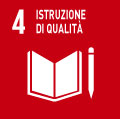- Docente: Gabriella Teti
- Crediti formativi: 3
- SSD: BIO/16
- Lingua di insegnamento: Inglese
- Moduli: Gabriella Teti (Modulo 1) Fiorenza Stagni (Modulo 2)
- Modalità didattica: Convenzionale - Lezioni in presenza (Modulo 1) Convenzionale - Lezioni in presenza (Modulo 2)
- Campus: Rimini
- Corso: Laurea Magistrale in Advanced Cosmetic Sciences (cod. 9225)
-
Orario delle lezioni (Modulo 1)
dal 09/10/2024 al 22/11/2024
-
Orario delle lezioni (Modulo 2)
dal 20/11/2024 al 04/12/2024
Conoscenze e abilità da conseguire
Dopo aver frequentato questo corso e aver superato l’esame finale, lo studente conosce la citologia, l’istologia, l’anatomia della pelle e degli annessi cutanei e le variazioni morfologiche e funzionali connesse con i processi di invecchiamento
Contenuti
Unit 1: Skin Anatomy
the eukaryotic cell
Cell membrane
- structure, cell membrane proteins, definition of permeability
Cytoplasm
- cytoskeleton (microfilaments, intermediate filaments and microtubules)
- organelles (mitochondria, rough endoplasmic reticulum, Golgi complex, lysosomes and perossisomes)
Nucleus
- chromatin, DNA complexed with histone proteins, nucleolus
Introduction to Histology:
Epithelial tissue: organization. Protective and secretive epithelia.
Connective tissue: cells and extracellular matrix components. Classification of connective tissues
Blood
Adipose tissue: description of adipocytes
Nervous tissue: neurons, glial cells
The integumentary system: general features
Components of the skin
Epidermis
- keratinocytes, melanocytes, Langerhans cells
- layers of epidermis
- cell junctions
- Keratinization and growth of the epidermis
Dermis
- cells
- extracellular matrix components
Hypodermis
Skin annexes
Hair follicles
Fingernails
Sebaceous glands
Sweat glands
Cutaneous sensitivity
Sensory receptors: free nervous endings, Meissner corpuscles, Ruffini corpuscles, Pacini corpuscles, Merkel cells.
Location and structure of olfactory epithelium
Oral cavity and taste receptors
Morphological changes of the skin connected with aging
Unit 2: skin physiology
Specific functions of the skin layers (epidermis, dermis and hypodermis) and skin annexes (hair, nails, sweat glands and sebaceous glands).
Protective functions: mechanical, physical (against radiations, temperature, electricity), chemical and biological (including immune) protection.
Permeability and prevention of dehydration.
Vitamin D synthesis.
Sensory functions: physiology of sensory receptors for touch, proprioception, thermoception, pain (somatosensory system), smell (olfactory system) and taste (gustatory system); adequate stimuli, mechanisms of signal transduction, genesis and propagation of bioelectrical signals, ascending neural pathways, cortical representation and elaboration.
Autonomic nervous system (regulation of activity; efferent pathways; sympathetic and parasympathetic divisions; neurotransmitters and receptors).
Thermoregulatory functions: vascularization of the skin, autonomic regulation, mechanisms of thermogenesis and thermodispersion.
Testi/Bibliografia
Anatomy & Physiology, J. Gordon Betts et al., OpenStax, Rice University (Houston, Texas, U.S.A.), 2017.
Articles and other materials provided in the classroom.
Metodi didattici
Lectures are conducted in a classroom using Power Point presentations.
Modalità di verifica e valutazione dell'apprendimento
Student learning in the Course “Skin and skin annexes Anatomy and Physiology” will be assessed in oral tests, each of them evaluated in thirtieths; students must have passed the first test to take the second one. 1) The first test concerns the teaching module "Skin and skin annexes Anatomy"; 2) the second test (which can be taken on the same day or later, within the same exam window) concerns the teaching module 2 regarding the skin physiology.
Each test is passed if the mark is equal to or higher than 18/30.
The final mark is the arithmetic average of the marks reported in the three modules of the course "Skin, skin annexes and diseases".
Strumenti a supporto della didattica
Projector and Laptop
Orario di ricevimento
Consulta il sito web di Gabriella Teti
Consulta il sito web di Fiorenza Stagni
SDGs

L'insegnamento contribuisce al perseguimento degli Obiettivi di Sviluppo Sostenibile dell'Agenda 2030 dell'ONU.
